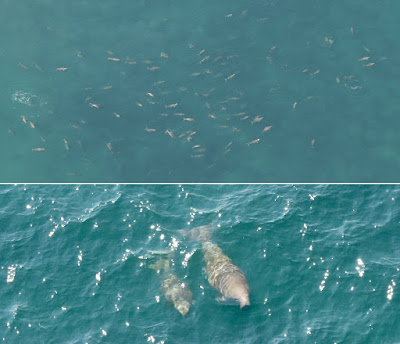 |
| Sobrarbesiren cardieli Díaz-Berenguer, Badiola, Moreno-Azanza & Canudo, 2018 |
Abstract
Sirenians are the only extant herbivorous mammals fully adapted to an aquatic lifestyle. They originated in Africa during the Paleocene from an undetermined clade of afrotherian mammals, and by the end of the Eocene they were widely distributed across the tropical latitudes. Here we introduce Sobrarbesiren cardieli gen. et sp. nov. It is the first adequately-known quadrupedal sirenian from Eurasia and the oldest record of this clade from western Europe. Fossils have been recovered from the middle Lutetian (SBZ15) site of Castejón de Sobrarbe-41 (Huesca, Spain), and comprise many cranial and postcranial remains, including pelvic girdle and hind limb bones, from at least six sirenian individuals of different ontogenetic stages. Sobrarbesiren shows a suite of characters previously considered synapomorphies of different clades of derived sirenians, such as the presence of the processus retroversus of the squamosal and the pterygoid fossa, combined with ancestral characters such as the presence of an alisphenoid canal, a permanent P5, at least two sacral vertebrae, a primitive pelvis and functional femora and fibulae. Sobrarbesiren is recovered as the sister taxon of Dugongidae and represents a transitional stage of adaptation to aquatic life between the amphibious quadrupedal prorastomids and the aquatic quadrupedal protosirenids.
Systematic palaeontology
Class Mammalia Linnaeus, 1758
Superorder Afrotheria Stanhope et al., 1998
Mirorder Tethytheria McKenna, 1975
Order Sirenia Illiger, 1811
Family uncertain
Sobrarbesiren cardieli gen. et sp. nov.
Etymology: In reference to the Sobrarbe region (Huesca, northeastern Spain), and in honour of Jesús Cardiel Lalueza, who discovered the fossil site.
Holotype: MPZ 2017/1 a complete skull of a subadult individual which preserves alveoli of P1-4, a complete left P5, and M1-3 on both sides (Figs 2, 3, 4a,b,g,h and 5). The specimen is housed in the Museo de Ciencias Naturales de la Universidad de Zaragoza (MPZ) (Zaragoza, Spain). S. cardieli is the type species of the genus by monotypy and by original designation.
Locality and horizon: Only known from the Castejón de Sobrarbe-41 fossil site (CS-41), in Castejón de Sobrarbe, Huesca, Ainsa Basin in the southern Pyrenees, Sobrarbe Formation (middle Lutetian, early middle Eocene)21 (Fig. 1b).
Diagnosis: (Ch. Character state following the descriptions and numbering sequence of Domning (1994) as updated by Vélez-Juarbe et al. (2014) and Springer et al. (2015) (e.g., Ch. 102 (0) refers to state 0 of character 102)): sirenian, based on the following synapomorphies: retracted and enlarged external nares (Ch. 8 (1)); premaxilla contacts the frontals (Ch. 9 (1)); and a P1-5, M1-3 postcanine dental formula (Ch. 155 (1)); and characterized by the following combination of characters (autapomorphies highlighted with*): upper dental formula 2.1.5.3 (I2 absent); pterygoid fossa present, extending above the level of the roof of the internal nares (Ch. 102 (1)); alisphenoid canal present (Ch. 101 (0)); rectangular and elongated basioccipital* (Fig. 4a,b and Supplementary Information Fig. S1a); hook-shaped acromion process of the scapula* (Fig. 7d), which extends just to the dorsal border of the glenoid fossa* (Fig. 7b); posterior iliac spine of the innominate bone present* (Fig. 9c); lateral iliac spine that appears abruptly on the lateral surface of the ilium with a flattened ventrolateral surface* (Fig. 9e).
 |
| Figure 10 Reconstructed composite skeleton of Sobrarbesiren cardieli gen. et sp. nov. Shaded elements represent the fossils studied. |
Conclusions:
We describe a new stem sirenian species, Sobrarbesiren cardieli, from the early middle Eocene (Lutetian, SBZ15) of the southern Pyrenees. This is the first adequately known quadrupedal sirenian from the northeastern Atlantic coast (Bay of Biscay, Spain) and the oldest sirenian from western Europe. It is represented by three skulls, cervical, dorsal, lumbar, sacral and caudal vertebrae, complete anterior, middle and posterior ribs, four scapulae, two hemipelvises, and fore and hind limb bones. This large collection of skeletal elements in different ontogenetic stages constitutes the most complete sample of an early middle Eocene sirenian in the Old World. Our phylogenetic analyses place Sobrarbesiren cardieli most parsimoniously as the sister taxon of a paraphyletic Dugongidae, which gives rise to Trichechidae. Sobrarbesiren is the only Eurasian sirenian that preserves terrestrially-functional pelvic girdle and hind limb bones. These indicate an intermediate state of adaptation to the aquatic lifestyle between other groups of quadrupedal sirenians, (namely the plesiomorphic pelvis and hind limbs of prorastomids, versus the slightly more derived limbs of the protosirenids). A further study of the functional morphology of sirenian hind limbs may be one of the keys to understanding the first stages of adaptation to aquatic life by these marine mammals.
Ester Díaz-Berenguer, Ainara Badiola, Miguel Moreno-Azanza and José Ignacio Canudo. 2018. First Adequately-known Quadrupedal Sirenian from Eurasia (Eocene, Bay of Biscay, Huesca, northeastern Spain). Scientific Reports. 8, Article number: 5127. DOI: 10.1038/s41598-018-23355-w
---------------------------------------------------------------
روابط التحميل والمشاهدة، الروابط المباشرة للتحميل
او
شاهد هذا الفيديو القصير لطريقة التحميل البسيطة
كيف تحصل على مدونة جاهزة بآلاف المواضيع والمشاركات من هنا
شاهد قناة منتدى مدونات بلوجر جاهزة بألاف المواضيع والمشاركات على اليوتيوب لمزيد من الشرح من هنا
رابط مدونة منتدى مدونات بلوجر جاهزة بآلاف المواضيع والمشاركات في أي وقت حــــتى لو تم حذفها من هنا
شاهد صفحة منتدى مدونات بلوجر جاهزة بألاف المواضيع والمشاركات على الفيس بوك لمزيد من الشرح من هنا
شاهد صفحة منتدى مدونات بلوجر جاهزة بألاف المواضيع والمشاركات على الفيس بوك لمزيد من الشرح من هنا
تعرف على ترتيب مواضيع منتدى مدونات بلوجر جاهزة بآلاف المواضيع والمشاركات (حتى لا تختلط عليك الامور) من هنا
ملاحظة هامة: كل عمليات تنزيل، رفع، وتعديل المواضيع الجاهزة تتم بطريقة آلية، ونعتذر عن اي موضوع مخالف او مخل بالحياء مرفوع بالمدونات الجاهزة بآلاف المواضيع والمشاركات، ولكم ان تقوموا بحذف هذه المواضيع والمشاركات والطريقة بسيطة وسهلة. ــــــــــــــــــــــــــــــــــــــــــــــــــــــــــــــــــــــــــــــسلامـ.















